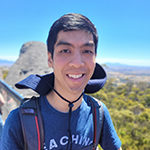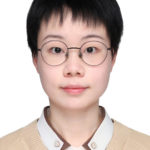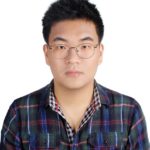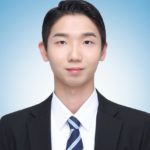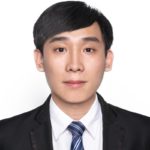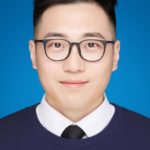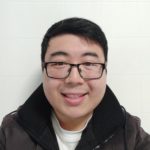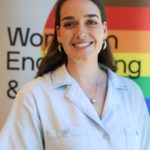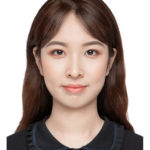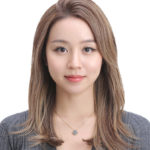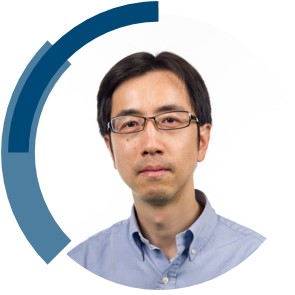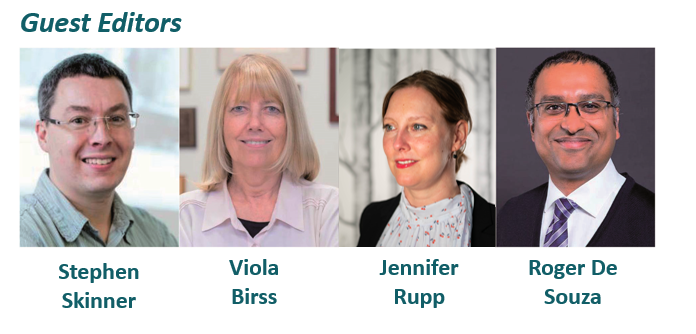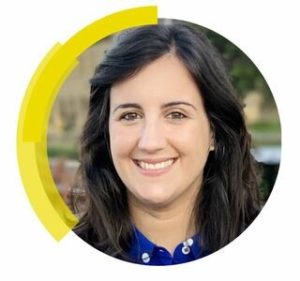Congratulations to the Journal of Materials Chemistry B winners of the Student Paper Contest at the 2021 Termis-AP. The 2021 TERMIS-AP Webinar Student Paper Contest was held as an on-line international symposium on 18-19 December 2021 in order to promote students for their research activity in tissue engineering and regenerative medicine in Asia and Pacific regions.
Journal of Materials Chemistry C and Materials Advances welcome Professor Ana Flavia Nogueira and Professor Zhiguo Xia to our Editorial Boards
Professor Ana Flavia Nogueira, Associate Editor, University of Campinas, Brazil
| Professor Ana Flavia Nogueira obtained her bachelor’s degree in Chemistry from the University of São Paulo (1996) and Master (1998) and PhD degrees in Chemistry from the University of Campinas (2001). She worked as a post-doctorate fellow at the Imperial College, UK, in 2001-2002 and as visiting researcher at Stanford University in 2017-2018. At the moment, she is Full Professor in the Chemistry Institute at UNICAMP and Director of the Center for Innovation on New Energies (CINE, www.cine.org.br). Professor Nogueira’s research focuses on the development of functional (nano)materials and their application in solar energy conversion. She has experience in the field of perovskite solar cells, perovskite quantum materials and dense energy carriers (generation of solar fuels through photoelectrocatalytic systems using water, CO2 and other low-added values substrates). | 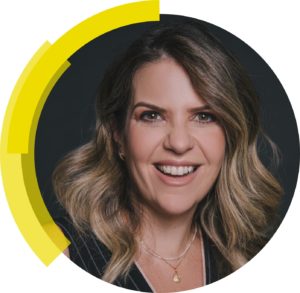 |
Read these publications by Professor Ana Flavia Nogueira in Royal Society of Chemistry journals:
Jeann Carlos da Silva, Francineide Lopes de Araújo, Rodrigo Szostak, Paulo Ernesto Marchezi, Raphael Fernando Moral, Jilian Nei de Freitas and Ana Flávia Nogueira
J. Mater. Chem. C, 2020, 8, 9697-9706, DOI: 10.1039/D0TC02078H
Reduced graphene oxide in perovskite solar cells: the influence on film formation, photophysics, performance, and stability
Paulo Ernesto Marchezi, Francineide Lopes de Araújo, Rodrigo Szostack, José Carlos Germino, Eralci M. Therézio, Alexandre Marletta and Ana Flavia Nogueira
J. Mater. Chem. C, 2021, 9, 14648-14658, DOI: 10.1039/D1TC01360B
Professor Zhiguo Xia, Associate Editor, South China University of Technology, China
Read these publications by Professor Zhiguo Xia in Royal Society of Chemistry journals:
Design optimization of CsPbBr3 nanocrystals into zeolite Beta composites as ultra-stable green emitters for backlight display applications
Bohan Li, Yuchi Zhang, Yan Xu and Zhiguo Xia
J. Mater. Chem. C, 2021, 9, 12118-12123, DOI: 10.1039/D1TC02757C
Recent progress of zero-dimensional luminescent metal halides
Mingze Li and Zhiguo Xia
Chem. Soc. Rev., 2021, 50, 2626-2662, DOI: 10.1039/D0CS00779J
We encourage you to submit your best work to Ana, Zhiguo and our team of Associate Editors now! Check out the Journal of Materials Chemistry C and Materials Advances author guidelines for more information on our article types.
Please join us in welcoming Professors Ana Flavia Nogueira and Zhiguo Xia to the Journal of Materials Chemistry C and Materials Advances Editorial Boards.
Editor’s Choice Collection: Perovskite-based solar cells
We are delighted to announce a new Journal of Materials Chemistry A and Materials Advances Editor’s Choice Collection on perovskite-based solar cells from Prof. Zhiqun Lin.
Newly appointed Journal of Materials Chemistry A and Materials Advances Advisory Board member Zhiqun Lin (Georgia Institute of Technology, USA), who has recently come to the end of his time as an Associate Editor, has gathered together the journals’ most outstanding recent papers in perovskite-based photovoltaics for this Editor’s Choice collection.
In order to highlight developments in perovskite-based solar cells, this online collection includes recent manuscripts from Journal of Materials Chemistry A and Materials Advances on the topic.
Papers published in Materials Advances are gold open access and freely accessible. Those published in Journal of Materials Chemistry A are free to access until Friday 8 April 2022. You can read the full collection online here.
Congratulations to all authors featured and we hope you enjoy browsing this collection of articles selected by Zhiqun Lin. We are also pleased to highlight that Zhiqun Lin has recently been appointed to our sister journals, Nanoscale and Nanoscale Advances.
Special issue in honour of Daoben Zhu
We are pleased to introduce a themed issue in honour of Prof. Daoben Zhu, on the occasion of his 80th Birthday. This special issue of Journal of Materials Chemistry C is a tribute to one of the pioneers of organic solids in China.
As one of the pioneers of modern organic materials, Professor Zhu’s creativity as well as his contribution to organic solids has inspired many young scientists and has also had a significant effect on global research. His achievements have received prestigious international recognition including the Lifetime Achievement Award of the Chinese Chemical Society (2021), Outstanding Science and Technology Achievement Prize of Chinese Academy of Sciences (2018), Academician of the Chinese Academy of Sciences (1997) and Fellow of the Royal Society of Chemistry (2001).
Guest Edited by Qichun Zhang, Wenping Hu, Thuc-Quyen Nguyen, Qibing Pei and Jia Zhu, it is a great honour to highlight contributions from a number of Prof Zhu’s former students, co-workers and friends which cover the design and preparation of new organic conjugated materials, the study of structure–property relationships and their potential applications in important devices including photovoltaics, organic spintronics, organic magnetics, organic thermoelectrics, organic memristors, organic transistors, organic optics, organic batteries, sensors, and bio-applications.
We hope you enjoy reading this Journal of Materials Chemistry C special issue in honour of Prof. Daoben Zhu. A selection of papers are included below or you can access the full issue here.
Editorial
Professor Daoben Zhu: a giant in organic solids in China
Qichun Zhang, Wenping Hu, Thuc-Quyen Nguyen, Qibing Pei and Jia Zhu
J. Mater. Chem. C, 2022, DOI: 10.1039/D2TC90014A
Reviews
The effect of side chain engineering on conjugated polymers in organic electrochemical transistors for bioelectronic applications
Yifei He, Nadzeya A. Kukhta, Adam Marks and Christine K. Luscombe
J. Mater. Chem. C, 2022, DOI: 10.1039/D1TC05229B
Recent progress in open-shell organic conjugated materials and their aggregated states
Shaoqiang Dong and Zhen Li
J. Mater. Chem. C, 2022, DOI: 10.1039/D1TC04598A
Communication
Cocrystal engineering for constructing two-photon absorption materials by controllable intermolecular interactions
Yihan Zhang,Hongnan Wu, Yuan Wang, Lingjie Sun, Shuyu Li, Yiwen Ren, Yajing Sun, Fangxu Yang, Xiaotao Zhang and Wenping Huac
J. Mater. Chem. C, 2022, DOI: 10.1039/D1TC04257B
Papers
Organic–inorganic hybrid metallic conductors based on bis(ethylenedithio)tetrathiafulvalene cations and antiferromagnetic oxalate-bridged copper(ii) dinuclear anions
Bin Zhang, Yan Zhang, Zheming Wang, Dongwei Wang, Deliang Yang, Zengqiang Gao, Guangcai Chang, Yanjun Guo, Takehiko Mori, Zhijuan Zhao, Fen Liu, Qiaolian Lie and Daoben Zhu
J. Mater. Chem. C, 2022, DOI: 10.1039/D1TC04305F
Photopatternable solid electrolyte for integrable organic electrochemical transistors: operation and hysteresis
Anton Weissbach, Lukas M. Bongartz, Matteo Cucchi, Hsin Tseng, Karl Leo and Hans Kleeman
J. Mater. Chem. C, 2022, DOI: 10.1039/D1TC04230K
Themed issue: In honour of Prof John Kilner
We are delighted to share with you a new Journal of Materials Chemistry A themed issue in honour of Prof John Kilner, on the occasion of his 75th birthday!
During his long, productive career, John Kilner has made numerous seminal contributions to the broad field of Energy Materials, advancing the fundamental understanding of critical processes in solid state batteries and solid oxide cells, and in particular, pioneering the development of methods to directly measure the ionic transport of species in solids. His work has transformed our understanding of the kinetics of surface exchange and diffusion in solids, including the cation segregation process at surfaces, transport along and across grain boundaries, as well as the effect of strain on ion mobility. More recently, he has extended his work to provide unique insights into the development of Li conducting garnet type solid state electrolytes, including focusing on processing of these materials and understanding the impact of humidity on function and stability. We hope that you will join us in celebrating his achievements and continued contributions to the field.
We hope you enjoy reading this collection of papers in Journal of Materials Chemistry A in honour of John Kilner, and guest edited by Stephen Skinner, Viola Birss, Jennifer Rupp and Roger De Souza. A selection of papers can be found below, or you can access the full issue here.
Editorial
Introduction to the special issue in honour of Prof. John Kilner’s 75th birthday
Stephen J. Skinner, Viola Birss, Jennider Rupp and Roger A. De Souza
Mater. Chem. A, 2022, 10, 2149-2151 DOI: 10.1039/D2TA90015G
Reviews
Recent advances, practical challenges, and perspectives of intermediate temperature solid oxide fuel cell cathodes
Amanda Ndubuisi, Sara Abouali, Kalpana Singh and Venkataraman Thangadurai
J. Mater. Chem. A, 2022, 10, 2196-2227 DOI: 10.1039/D1TA08475E
A review on dual-phase oxygen transport membranes: from fundamentals to commercial deployment
Ragnar Kiebach, Stéven Pirou, Lev Martinez Aguilera, Astri Bjørnetun Haugen, Andreas Kaiser, Peter Vang Hendriksen, María Balaguer, Julio García-Fayos, José Manuel Serra, Falk Schulze-Küppers, Max Christie, Liudmila Fischer, Wilhelm Albert Meulenberg and Stefan Bauman
J. Mater. Chem. A, 2022, 10, 2152-2195 DOI: 10.1039/D1TA07898D
Articles
Anharmonic lattice dynamics of superionic lithium nitride
Gabriel Krenzer, Chang-Eun Kim, Kasper Tolborg, Benjamin J. Morgan and Aron Walsh
J. Mater. Chem. A, 2022, 10, 2295-2304 DOI: 10.1039/D1TA07631K
Atomic-scale investigation of cation doping and defect clustering in the anti-perovskite Na3OCl sodium-ion conductor
Benedek A. Goldmann, Matt J. Clarke, James A. Dawson and M. Saiful Islam
J. Mater. Chem. A, 2022, 10, 2249-2255 DOI: 10.1039/D1TA07588H
Theoretical study on stability and ion transport property with halide doping of Na3SbS4 electrolyte for all-solid-state batteries
Randy Jalem, Bo Gao, Hong-Kang Tian and Yoshitaka Tateyama
J. Mater. Chem. A, 2022, 10, 2235-2248 DOI: 10.1039/D1TA07292G
2021 Journal of Materials Chemistry Lectureship winner: Maria Escudero Escribano
We are delighted to announce that Professor María Escudero Escribano has been selected as the winner of the Journal of Materials Chemistry Lectureship 2021. To celebrate, we have put together a collection of her publications in Royal Society of Chemistry journals:
María is currently a Professor at Catalan Institute of Nanoscience and Nanotechnology, Barcelona, Spain. However, in 2021 when she received the lectureship award, she was an Associate Professor of Chemistry at the University of Copenhagen, where her group investigated tailored interfaces and electrocatalyst materials for renewable energy conversion and electrosynthesis of green fuels and value-added chemicals. She graduated in Chemical Engineering from the University of Extremadura and obtained her Ph.D. in Chemistry from the Autonomous University of Madrid in 2011. She then started her postdoctoral research at the Technical University of Denmark and was a ‘DFF: Sapere Aude Research Talent’ fellow at Stanford University, before moving to the University of Copenhagen in 2017.
María is a ‘Villum Young Investigator’ (2018-2023) and co-PI of the Center for High Entropy Alloy Catalysis. Her work combines the insight from model studies on well-defined electrochemical interfaces with real systems and advanced materials for catalysis and renewable energy applications. María is a co-inventor of three patents on novel catalyst materials for electrochemical energy conversion. In addition to her regular invited, plenary and keynote lectures at international conferences and invited seminars at universities, she is highly involved in scientific outreach and dissemination activities.
María has received numerous awards at international and national levels in recognition of her groundbreaking research. These awards include the European Young Chemist Award 2016 (Gold Medal) from EuChemS, the Princess of Girona Foundation Scientific Research Award 2018, the Electrochemical Society Energy Technology Division Supramaniam Srinivasan Young Investigator Award 2018, the Spanish Royal Society of Chemistry Young Researchers Award 2019, and the Clara Immerwahr Award 2019.
The Journal of Materials Chemistry annual lectureship, established in 2010, honours early-career scientists who have made a significant contribution to the field of materials chemistry.
The Lectureship recipient receives expenses to cover travel and accommodation costs to attend and present at a leading international meeting. The recipient is also invited to contribute an article to one of the Journal of Materials Chemistry journals and to receive a complimentary back cover for the issue in which the article appears.
Please join us in congratulating María on receiving the award.
Open call: themed issue “New era in advanced functional materials emerging from molecular imprinting and related techniques”
|
Journal of Materials Chemistry B is delighted to announce a call for papers for its latest themed issue on “New era in advanced functional materials emerging from molecular imprinting and related techniques” to be published in 2022. Guest Edited by: Toshifumi Takeuchi (Kobe University, Japan), Karsten Haupt (Université de Technologie de Compiègne, France), and Guoping Chen (National Institute for Materials Science, Japan) Recent developments in molecular imprinting and related technologies have attracted a great deal of attention in the field of materials science. Many scientists and engineers in academia and industry, in the analytical, biomedical, environmental and materials sciences are interested in molecularly imprinted polymers (MIPs). Unfortunately, the 11th International Conference on molecular imprinting (MIP2020), due to be held in Hiroshima (Japan), has been cancelled due to the COVID-19 pandemic. Even under such circumstances, work has continued to develop new MIPs. Therefore, this themed issue of Journal of Materials Chemistry B aims to collect the latest information on MIP research, act as the most relevant venue for sharing new ideas and recent advances, and accelerate future developments in molecular imprinting and related techniques, in place of the MIP2020 conference. The scope of this themed collection ranges from new concepts and principles to advanced preparation techniques and industrial applications, including design, synthesis and characterization, affinity separation, sensing, and biological applications. This call for papers is open for the following article types: |
|
Submission Deadline: 7 February 2022
|
|
If you would like to contribute to this themed issue, you can submit your article directly through the journal’s online submission service at https://mc.manuscriptcentral.com/jmchemb. Please add a “note to the editor” in the submission form when uploading your files to say that this is a contribution to the themed issue. The Editorial Office reserves the right to check suitability of submissions in relation to the scope of the collection, and inclusion of accepted articles in the final themed issue is not guaranteed. Submissions to the journal should contain chemistry in a materials context and should fit within the scope of Journal of Materials Chemistry B. Please see the journal’s website for more information on the journal’s scope, standards, article types and author guidelines. |
Editor’s Choice collection: Spiro Compounds for Electronics
We are delighted to announce a new Journal of Materials Chemistry C Editor’s Choice Collection on spiro compounds for electronics.
| Advisory Board member for Journal of Materials Chemistry C, Cyril Poriel (Université de Rennes and CNRS, France), has selected outstanding recent manuscripts on spiro compounds for electronics for this Editor’s choice collection. In order to highlight developments in spiro compounds, this collection features articles from Journal of Materials Chemistry C and Materials Advances
You can read the full collection online. |
 |
Journal of Materials Chemistry C call for papers: Materials for thermally activated delayed fluorescence and/or triplet fusion upconversion
| Journal of Materials Chemistry C is delighted to announce a call for papers for its latest themed collection on “Materials for thermally activated delayed fluorescence and/or triplet fusion upconversion” to be published in early 2022. Guest Edited by: Eli Zysman-Colman (University of St Andrews), Malika Jeffries-EL (Boston University), and Nobuhiro Yanai (Kyushu University)
This issue aims to highlight the recent advances in the design of new materials that exhibit the thermally triggered phenomena of delayed fluorescence and/or the triplet-triplet annihilation-based photon upconversion. This includes topics on the theoretical and physical design of new materials and the opportunities created by exploiting the unique features of these molecular systems in the field of organic light-emitting diodes and sunlight-powered devices. This call for papers is open for the following article types: |
|
Submission Deadline: 14th October 2021
|
|
If you would like to contribute to this themed issue, you can submit your article directly through the journal’s online submission service at https://mc.manuscriptcentral.com/jmchemc. Please add a “note to the editor” in the submission form when uploading your files to say that this is a contribution to the themed issue. The Editorial Office reserves the right to check suitability of submissions in relation to the scope of the collection, and inclusion of accepted articles in the final themed issue is not guaranteed. Submissions to the journal should contain chemistry in a materials context and should fit within the scope of Journal of Materials Chemistry C. Please see the journal’s website for more information on the journal’s scope, standards, article types and author guidelines. With best wishes, |
|
|
|
|
Journal of Materials Chemistry A call for papers: Single-Atom Catalysis
| Journal of Materials Chemistry A is delighted to announce a call for papers for its latest themed collection on “Single-Atom Catalysis” Guest Edited by: Zhiqun Lin (Georgia Institute of Technology, USA) , Maria Escudero Escribano (University of Copenhagen, Denmark), and Jun Li (Tsinghua University, China)
Single-atom catalysts (SACs) with isolated metal atoms dispersed on solid supports have emerged as a new frontier in catalysis science owing to their great potential to bridge the gap between heterogeneous and homogeneous catalysis. The active centers of this new class of materials possess unique electronic structure and unsaturated coordination environments, which have been proven to improve catalytic activity in a variety of reactions. Moreover, the homogeneity in the active sites and geometric structure of SACs, which show similarities to their homogeneous catalyst analogs, afford them a great potential to enhance selectivity because of similar spatial and electronic interactions to substrates. In this context, it is pertinent to compile this themed issue centering on recent rapid development in the field of SACs. To this end, this themed collection of Journal of Materials Chemistry A aims at providing a platform for recent developments in this rapidly evolving field of SACs including synthetic strategies, selectivity regulation, theoretical understanding of the catalytic activity and stability, single-atom alloy, support effect, and novel applications in electrocatalysis, photocatalysis, photoelectrocatalysis, selective hydrogenation, and other fields. We hope that readers find this themed collection informative and useful. This call for papers is open for the following article types: |
|
Submission Deadline: 27th September 2021
|
|
If you would like to contribute to this themed issue, you can submit your article directly through the journal’s online submission service at https://mc.manuscriptcentral.com/jmchema. Please add a “note to the editor” in the submission form when uploading your files to say that this is a contribution to the themed issue. The Editorial Office reserves the right to check suitability of submissions in relation to the scope of the collection, and inclusion of accepted articles in the final themed issue is not guaranteed. With best wishes, |
|
|
|
|


